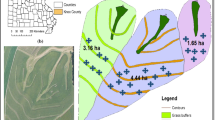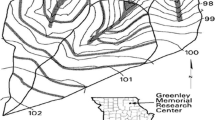Abstract
Agroforestry buffers are believed to enhance soil quality parameters in agricultural landscapes. Soil enzyme activities, water stable aggregates (WSA), soil organic carbon (SOC), and total nitrogen (N) have been identified as good indices of soil quality. The objective of this study was to quantify soil quality differences among agroforestry buffer (AGF), grass waterway (GWW), grass buffer (GB), and row crop (RC) areas and distance from the tree base on corn (Zea mays L.)-soybean (Glycine max L.) watershed. Soil samples from AGF at 0, 30, 60, 90 cm distances from the tree base, and from AGF, GWW, GB, and RC areas were collected from summit, shoulder, and foot-slope landscape positions at the paired watershed study near Novelty, MO. Soil enzyme activity, WSA, soil C, and N were determined and data were analyzed statistically. The highest SOC and N percentages were found in AGF and the lowest in RC. β-Glucosidase activity was not significantly different among AGF, GWW, and RC. β-Glucosaminidase and dehydrogenase activities were significantly lower in RC treatment than all other treatments. Fluorescein diacetate (FDA) hydrolase activity was not significant among all treatments. WSA percentage was significantly higher in GWW and AGF as compared to others. Landscape position was not significantly different for all measured soil quality parameters. β-Glucosidase, β-glucosaminidase activities, WSA, and soil N did not differ significantly with distance from the tree base. SOC and FDA hydrolase activity were significantly lower at the tree base. Results imply that permanent vegetation has improved the soil quality by enhancing soil microbial activity and organic matter accumulation, thereby contribute positively to watershed restoration.



Similar content being viewed by others
References
Acosta-Martínez V, Zobeck TM, Gill TE, Kennedy AC (2003) Enzyme activities and microbial community structure in semiarid agricultural soils. Biol Fertil Soils 38:216–227
Angers DA, Mehuys GR (1993) Aggregate stability to water. In: Carter MR (ed) Soil sampling and methods of analysis. Canadian Society of Soil Science, Lewis Publishers, Boca Raton, pp 651–657
Barthès B, Albrecht A, Asseline J, De Nonic G, Roosec E (1999) Relationship between soil erodibility and topsoil aggregate stability or carbon content in a cultivated Mediterranean highland (Aveyron, France). Commun Soil Sci Plant Anal 30:1929–1938
Decker KLM, Boerner REJ, Morris S (1999) Scale dependent patterns of soil enzyme activity in a forested landscape. Can J For Res 29:232–241
Dick RP, Breakwell DP, Turco RF (1996) Soil enzyme activities and biodiversity measurements as integrative microbiological indicators. In: Doran JW, Jones AJ (eds) Methods of assessing soil quality, vol 49. SSSA Special Publication, Madison, pp 247–271
Dillaha TA III, Inamdar SP (1996) Buffer zones as sediment traps or sources. In: Haycock NE et al (eds) Buffer zones: their processes and potential in water protection. Quest Environmental, Hertfordshire, pp 7–20
Doran JW, Parkin TB (1994) Defining and assessing soil quality, vol 35. SSSA Special Publication, Madison, pp 3–3
Ekenler M, Tabatabai MA (2003) Tillage and residue management effects on β-glucosidaminase activity in soils. Soil Biol Biochem 35:871–874
Escobar GA, Mackay AD, Hodgson J, Kemp PD (2002) Soil properties of a widely spaced, planted poplar (Populus deltoides)—pasture system in a hill environment. Soil Res 40:873–886
Gregorich EG, Beare MH, McKim UF, Skjemstad JO (2006) Chemical and biological characteristics of physically uncomplexed organic matter. Soil Sci Soc Am J 70:9705–9985. doi:10.2136/sssaj2005.0116
Ingham E (2000) The vermicompost foodweb: effects on plant production. Oral scientific sessions, the vermillenium (conference), Kalamazoo
Jose S (2009) Agroforestry for ecosystem services and environmental benefits: an overview. Agrofor Syst 76:1–10
Jose S, Bardhan S (2012) Agroforestry for biomass production and carbon sequestration. Agrofor Syst 86:105–112
Karlen DL, Mausbach MJ, Doran JW, Cline RG, Harris RF, Schuman GE (1997) Soil quality: a concept, definition, and framework for evaluation (a guest editorial). Soil Sci Soc Am J 61:4–10
Kremer RJ, Kussman RD (2011) Soil quality in a pecan–kura clover alley cropping system in the Midwestern USA. Agrofor Syst 83:213–223
Kremer RJ, Li J (2003) Developing weed-suppressive soils through improved soil quality management. Soil Till Res 72:193–202
Kumar S, Anderson SH, Udawatta RP (2010) Agroforestry and grass buffer influences on macropores measured by computed tomography under grazed pasture systems. Soil Sci Soc Am J 74:203–212
Lee KH, Isenhart TM, Schultz RC (2003) Sediment and nutrient removal in an established multi-species riparian buffer. J Soil Water Conserv 58(1):1–8
Lovell ST, Sullivan WC (2006) Environmental benefits of conservation buffers in the United States: evidence, promise, and open questions. Agric Ecosyst Environ 112:249–260
Lupwayi N, Arshad M, Rice W, Clayton G (2001) Bacterial diversity in water-stable aggregates of soils under conventional and zero tillage management. Appl Soil Ecol 16:251–261. doi:10.1016/S0929-1393(00)00123-2
Makoi JH, Ndakidemi PA (2008) Selected soil enzymes: examples of their potential roles in the ecosystem. Afr J Biotechnol 7:181–191
Mankin KR, Ngandu DM, Barden CJ, Hutchinson SL, Geyer WA (2007) Grass–shrub riparian buffer removal of sediment, phosphorus, and nitrogen from simulated runoff. J Am Water Resour Assoc 43(5):1108–1116
Mungai WN, Motavalli PP, Kremer RJ, Nelson KA (2005a) Spatial variation in soil enzyme activities and microbial functional diversity in temperate alley cropping systems. Biol Fertil Soils 42:129–136
Mungai WN, Motavalli PP, Kremer RJ, Nelson KA (2005b) Spatial variation in soil enzyme activities and microbial functional diversity in temperate alley cropping systems. Biol Fertil Soils 42:129–136
Nair VD, Graetz DA (2004) Agroforestry as an approach to minimizing nutrient loss from heavily fertilized soils: the Florida experience. In: Ramachandran Nair PK, Rao MR, Buck LE (eds) New vistas in agroforestry. Springer, Berlin, pp 269–279
Nelson DW, Sommers LE (1996) Total carbon, organic carbon, and organic matter. In: Sparks DL (ed) Methods of soil analysis-part 3, chemical methods. Soil Science Society of America Journal, Madison, pp 961–1010
Nii-Annang S, Grünewald H, Freese D, Hüttl RF, Dilly O (2009) Microbial activity, organic C accumulation and 13C abundance in soils under alley cropping systems after 9 years of recultivation of quaternary deposits. Biol Fertil Soils 45:531–538
Ogle SM, Breidt FJ, Eve MD, Paustian K (2003) Uncertainty in estimating land use and management impacts on soil organic carbon storage for US agricultural lands between 1982 and 1997. Glob Change Biol 9:1521–1542
Parham JA, Deng SP (2000) Detection, quantification, and characterization of β-glucosaminadase activity in soils. Soil Biol Biochem 32:1183–1190
Paudel BR, Udawatta RP, Anderson SH (2011) Agroforestry and grass buffer effects on soil quality parameters for grazed pasture and row-crop systems. Appl Soil Ecol 48:125–132
Paudel BR, Udawatta RP, Kremer RJ, Anderson SH (2012) Soil quality indicator responses to row crop, grazed pasture, and agroforestry buffer management. Agrofor Syst 84:311–323
Schultz RC, Isenhart TM, Colletti JP, Simpkins WW, Udawatta RP, Schultz PL (2009) Riparian and upland buffer practices. In: Garrett HE (ed) North American agroforestry: an integrated science and practice, 2nd edn. American Society of Agronomy, Madison, pp 163–213
Seobi T, Anderson SH, Udawatta RP, Gantzer CJ (2005) Influence of grass and agroforestry buffer strips on soil hydraulic properties for an Albaqualf. Soil Sci Soc Am J 69:893–901
Six J, Feller C, Denef K, Ogle SM, Sa JCM, Albrecht A (2002) Soil organic matter, biota and aggregation in temperate and tropical soils—effects of no-tillage. Agronomie 22:755–775
Six J, Frey SD, Thiet RK, Batten KM (2006) Bacterial and fungal contributions to carbon sequestration in agroecosystems. Soil Sci Soc Am J 70:555–569
Tabatabai MA (1994) Soil enzymes. In: Weaver RW, Angle JS, Bottomley PS (eds) Methods of soil analysis, microbiological and biochemical properties. SSSA Book, Madison, pp 775–833
Tilman D, Cassman KG, Matson PA, Naylor R, Polasky S (2002) Agricultural sustainability and intensive production practices. Nature 418:671–677
Udawatta RP, Jose S (2012) Agroforestry strategies to sequester carbon in temperate North America. Agrofor Syst 86:225–242
Udawatta RP, Krstansky JJ, Henderson GS, Garrett HE (2002) Agroforestry practices, runoff, and nutrient loss: a paired watershed comparison. J Environ Qual 31:1214–1225
Udawatta RP, Kremer RJ, Adamson BW, Anderson SH (2008) Variations in soil aggregate stability and enzyme activities in a temperate agroforestry practice. Appl Soil Ecol 39:153–160
Udawatta RP, Kremer RJ, Garrett HE, Anderson SH (2009) Soil enzyme activities and physical properties in a watershed managed under agroforestry and row-crop system. Agric Ecosyst Environ 131:98–104
Udawatta RP, Garrett HE, Kallenbach RL (2010) Agroforestry and grass buffer effects on water quality in grazed pastures. Agrofor Syst 79:81–87
Udawatta R, Kremer R, Nelson K, Jose S, Bardhan S (2014) Soil quality indicators of a mature alley cropping agroforestry system in temperate North America. Commun Soil Sci Plant Anal 45:2539–2551
Uri ND (2000) Agriculture and the environment—the problem of soil erosion. J Sustain Agr 16:71–94
Zalidis G, Stamatiadis S, Takavakoglou V, Eskridge K, Misopolinos N (2002) Impacts of agricultural practices on soil and water quality in the Mediterranean region and proposed assessment methodology. Agric Ecosyst Environ 88:137–146
Author information
Authors and Affiliations
Corresponding author
Rights and permissions
About this article
Cite this article
Weerasekara, C., Udawatta, R.P., Jose, S. et al. Soil quality differences in a row-crop watershed with agroforestry and grass buffers. Agroforest Syst 90, 829–838 (2016). https://doi.org/10.1007/s10457-016-9903-5
Received:
Accepted:
Published:
Issue Date:
DOI: https://doi.org/10.1007/s10457-016-9903-5




